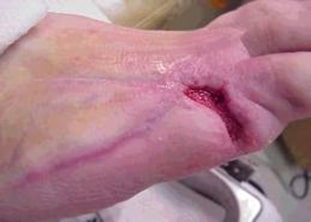The difference between saving or losing a limb often comes down to receiving optimal wound care.

Dr. Zakhary is passionate about wound care and has extensive knowledge and training in treating all types of wounds. He is board certified in vascular surgery and board certified in general surgery. He has completed 7 years of formal surgical training, including a vascular and endovascular surgery fellowship at Baylor University.
Dr. Zakhary is well versed on multiple wound care and limb salvage techniques and procedures including:
- Revascularization – Endovascular and Surgical
- TCC – Total Contact Casting
- Foot Strapping and advanced Offloading Techniques
- Achilles Tendon Lengthening
- Gauze hydrogel, hydrocolloid, foam, transparent film, calcium alginates, chemical debriding agents, growth factors, compression dressings, and biological dressings.
- NPWT – Negative Pressure Wound Therapy
- Skin Substitutes (Cellular Tissue Products)
- Split Thickness Skin Grafting
- SGHMC – Sustained, Graduated, High–Moderate Compression
- HBOT – Hyperbaric Oxygen Therapy
- Excisional Debridement
Should I See a Doctor for My Wound?
There are certain signs that your cut or wound is beyond simply needing a Band-Aid. If any of these sound like your wound, you need to call a doctor.
The wound:
- Won’t stop bleeding after 10-15 minutes of pressure
- Is deeper than a half-inch
- Is very near the eye
- Is gaping or ragged
- Was caused by something dirty or rusty
- Has dirt or gravel stuck in it
- Is very painful
- Shows signs of infection
- Was created by an animal or human bite
How Are Open Wounds Treated?

For some wounds, it’s a better idea to not close the wound, but to let it heal naturally. This is known as “healing by secondary intention,” meaning the wound will heal from the bottom to the outer epidermis. In these cases, the wound will be packed with gauze rather than closed with sutures. This can be necessary in some cases where there is a serious risk of infection and the formation of abscesses.
For more involved wounds, Dr. Zakhary may need to prescribe a round of antibiotics or penicillin to ward off possible infection. Pain medication is also possible. If the wound is overly complex, it may require surgery.
If the wound involves the loss of a body part, you need to bring that part with you to the emergency room at the hospital for possible reattachment.
How Does a Wound Fully Heal?
A wound by definition is a cut or opening in the skin. These can be as small as a paper cut or a large laceration from a car accident. The human body’s healing process is incredible, and it works in stages:
Stage 1: Stopping the Bleeding (Hemostasis)
Stopping the bleeding (hemostasis) — Blood begins to clot seconds to minutes after you get a wound. Clotting helps prevent too much blood loss, and it helps to close the wound and initiate the healing process.
Stage 2: Scabbing Over
Clotting and the formation of a scab takes these steps:
- Blood vessels around the wound constrict to slow bleeding.
- Platelets in the blood clump together to form a plug in the wound.
- Clotting or coagulation includes a protein called fibrin. This is blood glue that makes a mesh over the platelet plug, keeping it in place. This is now a scab.
- Inflammation works to clean and heal the injury.
Stage 3: Rebuilding
Once the wound stabilizes, your body gets busy rebuilding the site. Oxygen-rich red blood cells are sent to the wound to create new tissue. Chemical signals initiate a wound-healing response, where more collagen fiber is created. This fiber will help to repair the skin and tissues in the wound. Collagen is like a scaffold that other cells can build upon. This stage of healing may produce a raised, red scar. This will slowly fade in color and flatten.
Stage 4: Maturation
At this stage, the wound looks closed and healed, but the body’s still working on repair. The scar may look pink and stretched or puckered. It may feel tight. It may itch. Your body works to continue to repair, improve, and strengthen the new tissue
How Long Does It Take for an Open Wound to Heal Properly?
The speed of healing depends on how large or deep the cut is. Deep wounds can actually take years to fully heal. Open wounds take longer to heal than closed wounds. This is because the sutures close up and reduce the area the body has to rebuild.
In most cases, after about 3 months most wounds are repaired. The new tissue skin and tissue is about 80 percent as strong as it was before it was injured.
Surgical wounds typically heal faster than naturally occurring wounds, healing in from 6 to 8 weeks in most cases.
Wounds often heal faster and more cleanly if they are kept covered.
How Will I Know if My Wound is Not Healing Properly?
Blood is key to efficient wound healing. Blood carries oxygen, nutrients, and everything else your body needs to heal the wound site. If a wound isn’t getting enough blood, it can take twice as long to heal.
How does this happen? Almost 6.5 million people in the U.S. have wounds that don’t heal well. Age is one factor, as the vascular system in older adults isn’t as strong, leading to slower wound healing. A “chronic” wound heals very slowly or not at all.
These health conditions may lead to poor blood circulation:
- Diabetes
- Obesity
- High blood pressure
- Vascular disease
A wound that is healing more slowly can also be a sign of infection. The healing process is slowed because the body has to first clean and protect the wound, warding off the potential invaders, before it can get down to rebuilding the tissue.
An infection occurs when bacteria, fungi, and other germs get into the wound before it fully heals. These are signs your wound may be infected:
- Slow healing
- Swelling
- Redness
- Pain or tenderness
- Hot or warm to the touch
- Oozing pus or liquid
When a wound is infected, the treatment will include cleaning the wound, removing dead or infected tissue around the wound, and the application of antibiotic skin ointment and possible oral antibiotics.
Why Should I Worry About a Wound Becoming Infected?
Keeping your healing wound clean needs to be your first priority. Yes, the body can fight off many infections successfully, but it isn’t always successful. These are the complications that can occur from an infected open wound:
- Lockjaw — This condition is caused by an infection from the bacteria that cause tetanus. This can lead to muscle contractions in your jaw and neck.
- Necrotizing fasciitis — This is a severe soft tissue infection caused by a variety of bacteria including Clostridium and Streptococcus that can lead to tissue loss, sepsis, and possible death.
- Cellulitis — This is an infection of your skin that’s not in immediate contact with the wound.
See What Our Patients Are Saying!
"This doctor and his staff make you feel like family. They all go over and beyond in every way. They keep you informed, work way beyond the limits of a normal workday, and all stay completely involved in your personal needs. I must copy another persons comment that he and all in his staff are way beyond the GOLD standard... Dr. Zakhary deserves all the best for being so thoughtful and truly caring man. I don’t know if there is another as good anywhere."
"This office has an amazing staff and Dr. Zachary is one of the best doctors I’ve ever seen! He’s great at his profession, he’s very personable, and funny"
"The staff with Sammy A. Zakhary is top notch. Very warm and friendly and accommodating. You are in good hands here."
"Dr. Zakhary is very thorough. He cares for his patients, takes time too listen and plan the next best step for care. Highly recommend him!"
Schedule Your Appointment Today!
For more information or to schedule your appointment with Dr. Zakhary, give us a call today at (623) 258-3255. Our practice serves Glendale, AZ and the surrounding areas.

